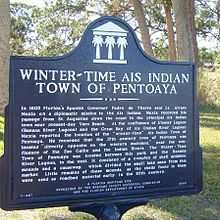Alvaro Mexia

Alvaro Mexia was a 17th-century Spanish explorer and cartographer of the east coast of Florida. Mexia was stationed in St Augustine and was given a diplomatic mission to the native populations living south of St. Augustine and in the Cape Canaveral area. This mission resulted in a "Period of Friendship" between the Spanish and the Ais native population.
When Pedro de Ibarra became the Spanish Governor of Florida, he knew the Spanish needed to improve relations with the natives, so he sent Mexia on a diplomatic mission in 1605 to gain knowledge of the lands and populations south of St.Augustine.
Mexia wrote about his experiences in the area of the native Ais in a document known as a Derrotero, a truthful account and description of his journey in the land of Ais.[1] Mexia also created a map[2] in color. His journey completed in 1605, his Derrotero and map were sent to the King of Spain in a letter from Pedro de Ibarra.
His letters and map show native towns and place names south of St. Augustine. These include:
- Surruque In New Smyrna Beach. Mexia and his party arrived at Surruque on June 6, 1605 and remained in the area for eight days while he waited for orders to proceed to the Ais Indian Nation.
- Nocoroco town - mouth of Tomoka River,in Volusia County.[3]
- After leaving Nocoroco Mexia writes about passing by a Buhio [4] A West Indian (Arawak) word for a native hut. It came to be applied to anything from the family dwelling to the large communal lodge which according to Bishop Calderon, would accommodatge 2000 to 3000 people.
- Caparca site - New Smyrna (Volusia County)
- Potopotoyachequeya - Haulover Canal, place where native Americans crossed land with their canoes
- Savo
- Lagoon of Sababoche - present-day Banana River
- Lagoon of Savochequueya - present-day Newfound Harbor in Merritt Island, Florida
- Lagoon of Ulumay
- Through "Callejon" to Pentoaya, A Distance of .5 leagues (1.5 mi)[5]
- Traverse of the Grand Bay of Ais 5 leagues (15 mi)
- Then to small fresh water river 1 league (3.0 mi)
- Then to the great Indian town of the Ais
Alvaro returned to St Augustine and made his report to Ibarra on July 11, 1605 more than a month after his departure. The mission was considered a success as on September 2, 1605 the elusive Capitan Grande (Ais Chief) finally arrived in St. Augustine accompanied by his mandador, the chiefs of Surruque and Urbia, and twenty Indians. Agreements were made that the Ais Indians would return shipwrecked sailors to the Spanish for a ransom.
References
- ↑ Rouse, Irving. Survey of Indian River Archaeology. Yale University Publications in Anthropology 45. ISBN 978-0-404-15668-8.
- ↑ Osborne, Ray (2008). Cape Canaveral. Images of America. Arcadia Publishing. p. 15. ISBN 978-0-7385-5327-6.
- ↑ , Florida Historical Society. The Florida Historical Quarterly, Vol. 27, No. 4 (April 1949), p344-345
- ↑ Rouse, Irving. Survey of Indian River Archaeology. Yale University Publications in Anthropology pg. 271. ISBN 978-0-404-15668-8.
- ↑ Higgs, Charles. Spanish Contacts with the Ais(Indian River Country). FHQ vol 21, no I, pp 25-39. ISBN 978-0-404-15668-8.
Further reading
- Library of Congress Archives: A copy of the Pedro de Ibarra letter referring Alvaro Mexia to the King of Spain is in v. 5, and Lowery's manuscript collections relating to Florida, 1603- 1607, archived in the Manuscript Division.
- Archive copies of Mexia's writings are archived at General Archive of the Indies
Catalogued as Simancas, La Florida: Descubrimientos, descripciones, y poblaciones de laFlorida. Patronato. Est I; Cat I Leg 1/19; No.29
- Duplicate: Simancas, Seculares, Audencia de Santo Domingo: Cartas y expedientes de gobernadores de la Florida vistos en el Consejo desde 1568 a Est 54: Caj. 5 Leg 9.
- Nocoroco mentions Alvaro Mexia
External links
- General Archive of the Indies in Seville, Spain
- Mexia's map of Florida in: Osborne, Ray (2008). Cape Canaveral. Images of America. Arcadia Publishing. p. 15. ISBN 978-0-7385-5327-6.